How to wrap a pull through
I don't know how many people out there have had trouble figuring out how the devil to wrap a pull through so it will fit into the butt trap of an Enfield rifle. Well here is the solution. Lewis "Vulture" Maynard of Mooloolaba Queensland has taken step by step pictures and explained just how to do the trick. Lewis learned from his Grandfather, who was an Australian Soldier.
Grasp the uppermost gauze loop in your left hand (or right hand if you are left handed), so that the middle of the loop is held by thumb and forefinger.
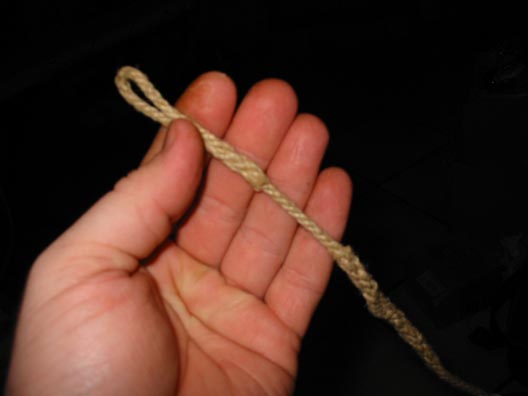
Go around the fingers so you have 2 loops, and the initial piece...
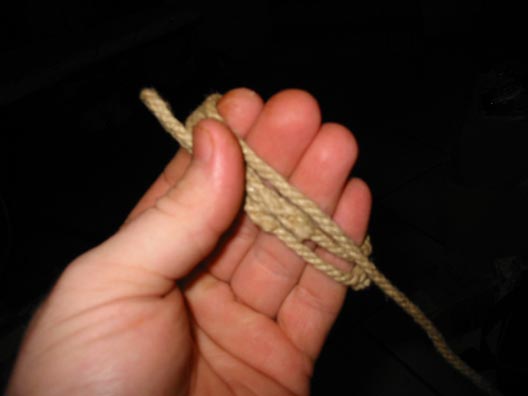
Now start wrapping, pretty tightly, from the base up...
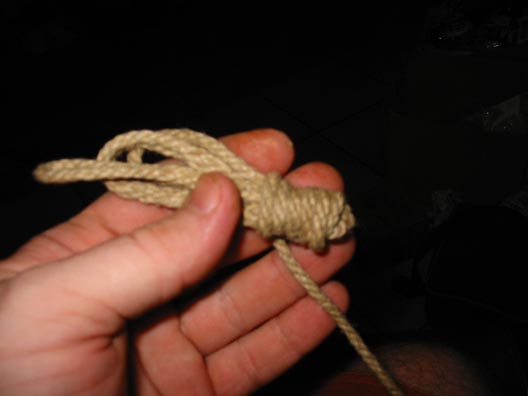
And now you have to insert the brass (sometimes steel / alloy) weight through the loops. Can be awkward, but important. Go through ALL the loops, ending with the extended loop...

And pull it through taught...kinda like tying a hangman's noose eh!
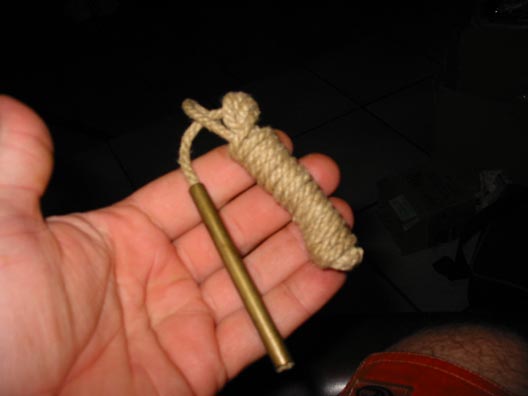
Now, fitting it in the trap. Here is where you go - the bundle goes into the hole on top of the oiler, and the weight goes into the small hole shown...
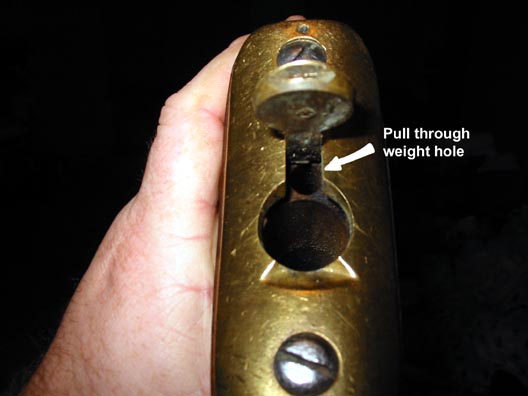
...like this....
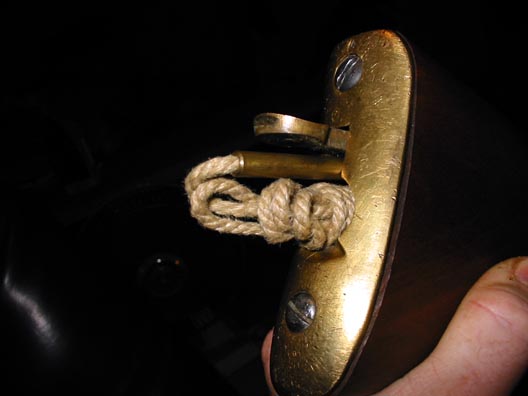
...and push it all the way in.
VOILA! And that, my friend is the art of wrapping and fitting a pull through!
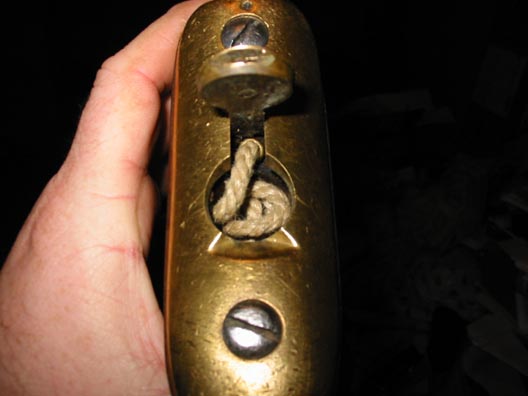
And here is the whole set up properly stored in the butt trap.
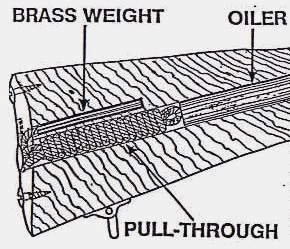
Now, about that funny bit of screen door mesh...
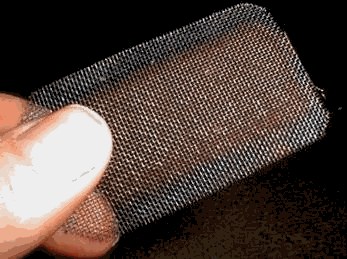
It's called "wire gauze" and it was used to clean rusty bores. It could only be used with the specific permission of an officer because it WILL damage the bore with continued use. If you have one of these, keep as a curio and go buy a nice, modern bronze bore brush to clean your rifle. For more information on how it was used, read on.
The following is taken from "The Service Rifle and How to Use it" Arraigned by Major T. J. Edwards, M.B.E., F.R.Hist.S. Published by Gale and Polden Limited, Aldershot.
Care and cleaning
1. When properly cared for, 5,000 to 6,000 rounds can be fired from a rifle before it becomes unserviceable. To prevent unnecessary wear caused by too frequent use of the gauze, the instructions for cleaning will be strictly adhered to.
2. When the rifle is not in use, the leaf and the slide of the backsight will be lowered.
3. The mainspring should never be allowed to remain compressed except when the rifle is loaded. The position of the cocking-piece shows whether the mainspring is compressed or not.
4. The magazine must not be removed from the rifle except for cleaning purposes, and, to avoid weakening the spring, cartridges should only be kept in it when necessary.
5. The bolts of rifles are not to be exchanged, as the use of the wrong bolt may affect the accuracy of the rifle. Each bolt is carefully fitted to a particular rifle, so that the parts which take the shock of the explosion have an even bearing. The number stamped on the bolt lever should agree with that stamped on the right front of the body.
6. Cleaning Materials
(a) The pull-through, which will be kept in the butt trap of the rifle, is provided with three loops. The first loop (the one nearest the weight) is for the wire gauze, the second for the flannelette, and the third for the purpose of removing the pull-through should it break or get jammed in the bore.
Before use it is important to see that the weight is not bent. The cord should be run through the fingers to straighten it and remove any grit.
- The pull-through will be used as follows; Drop the weight through the bore from breech to muzzle. The toe of the butt will be placed on the ground except on stone of concrete to ensure that the axis of the bore is in line with the direction of the pull. The soldier will hold the rifle firmly at the muzzle with his left hand to retain it in this position. The pull-through will be drawn through the barrel from breech to muzzle in one continuous motion. When permission is given to use a wire gauze, [see (e) below], a soldier may receive assistance in pulling it through his rifle. When such assistance is given, the soldier holding the rifle will keep the toe of the butt on the ground and ensure that the axis of the bore is in line with the direction of the pull. The responsibility for avoiding cordwear [see sub-para. (ii) below] will always rest with the owner of the rifle even when assistance is given to him in pulling the cord through.
- The cord must be drawn straight through and not allowed to rub against the muzzle of the bore, otherwise it will cause a groove to be worn where it rubs; this is known as "cordwear" and affect the accuracy of the rifle.
- The pull-through will be packed in the butt trap as follows; (see step by step instructions above)
- If a jam occurs with the pull-through the soldier must not attempt to remove the obstruction, but the rifle must be taken to the armourer.
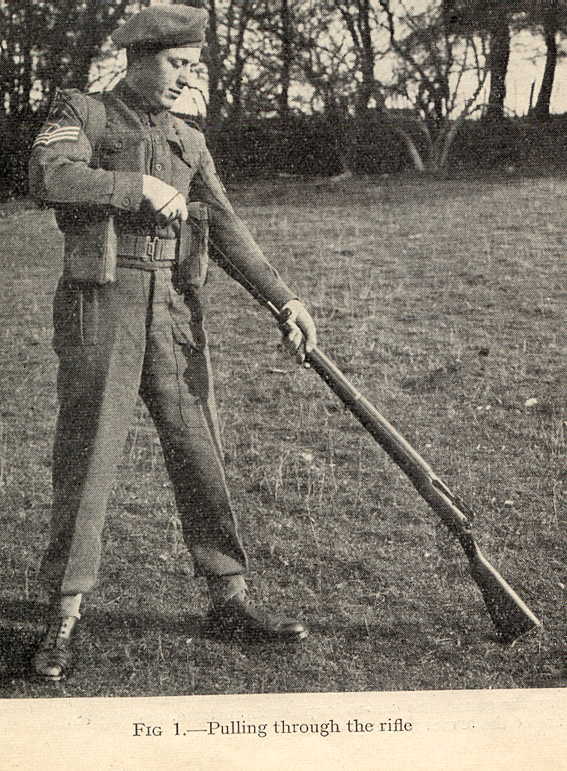
(b) Oil. Service oil(editor's note; any modern gun oil will work, ie: Hoppe's, CLP etc.) is carried in the oil bottle, for which a recess in the butt trap is provided. No other form of lubricant is to be allowed to remain in the bore. Paraffin(kerosene), though an effective agent for removing rust, will not prevent it.
(c) Flannelette. No other form of material will be used for cleaning the bore. For cleaning the bore after firing, a piece of flannelette, 4 inches by 2 inches, will be used. It will be placed in the second loop of the pull-through and wrapped around the cord.
For oiling the bore a slightly smaller piece of flannelette, 4 inches by 1
1/2 inches will be used. If the piece used is too big, the oil will be scraped off as it enters the bore. The oil should be well rubbed, with the fingers, into the flannelette.Click on picture to go to T.W. Chambers & Co. and order your own roll of flannelette
Picture Courtesy of Grant Rombough
(d) Stick, Cleaning Chamber, made of wood about a foot long; at one end a slot is cut, the other end is cut square to allow a grip to be taken and the stick to be turned by hand. A piece of dry flannelette is placed in the slot and wound round the stick (to ensure that the stick is covered). The stick is then passed through the boltway into the chamber and turned round several times. This is the only effective method of cleaning the chamber.
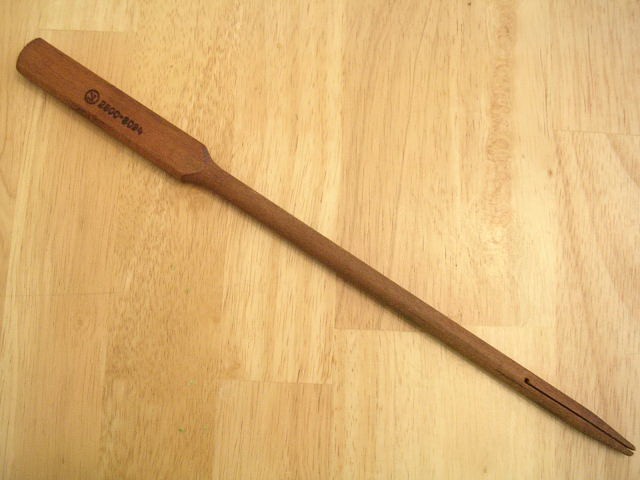
Issue Chamber Stick. Picture Courtesy of Wess Rodgers
(e) Wire gauze, in pieces 2
1/2 inches by 11/2 inches, is supplied, and except on active service, should only be used with the permission of an officer for the purpose of removing hard fouling or rust.In attaching it to the pull-through the following method will be adopted;
- Fold the gauze as in diagram, Fig. 9, so that the longer sides take the form of an "S".
- Open the first loop of the pull-through and put one side of it in each loop of the "S".
- Then coil each half of the gauze tightly round that portion of the cord over which it is placed until the two rolls thus formed meet.

The gauze must be thoroughly oiled before use and care taken to ensure that there are no loose strands of wire which may scratch the bore. The gauze should fit the bore tightly and will, if necessary, be packed with a small piece of flannelette or other soft material to ensure it so fitting.
The gauze should not be allowed to remain on the pull-through except on active service, when it will provide the normal means of cleaning the bore.
No material other than that issued from store is to be used in cleaning the rifle, and the use of cutting or gritty materials such as emery powder or bathbrick is forbidden. Care should be taken to prevent any unnecessary rubbing of the browned(blued) portions of the rifle, since the browning is a preventive against rust.
7. The following points in connection with the correct cleaning and care of rifles should be thoroughly understood by every man;
- Boiling water is an effective method of removing fouling. Its action is to dissolve the harmful matter in the products of combustion which can then be removed by the flannelette on the pull-through. This method should always be used when possible.
- Superficial fouling can be readily removed when the barrel is still warm by the use of the flannelette on the pull-through, but if allowed to remain in the bore it will harden and turn to red rust; the remove this it may be necessary to use the wire gauze.
- The surest method of preventing rust is to remove the fouling immediately after firing and before it has time to harden and form rust, and to keep the interior of the bore covered with a film of oil, which prevents the moisture of the air reaching the steel. Barrels will therefore always be kept slightly oily except;--
- Immediately before firing.
- At inspection in barrack rooms, when dry barrels may be ordered.
- Rust attacks a rough surface more readily than a smooth one, and consequently a bore that has once become rusty will require more care than one that has been carefully looked after.
8. Before cleaning the rifle, the bolt, magazine and sling will be removed and placed in a clean spot.
- Daily cleaning .-- The bore will be pulled through daily with a piece of oily flannelette. The exterior of the rifle and bayonet will then be cleaned with an oily rag, and all particles of dirt or dust removed from the gas escapes and crevices. The frictional parts will be oiled. Daily cleaning for a period of four or five days after firing, or when specially ordered, will be as above, except that the bore will be pulled through with dry flannelette until clean, and then immediately re-oiled.
- Cleaning before Firing .-- The bore will be thoroughly cleaned and all traces of oil removed; the action will be wiped with an oily rag, care being taken to see that the face of the bolt is free from oil and that the gas escapes are clear. Ensure that the magazine spring is in good order. In sandy or dusty countries the bolt should be dry. The cartridges and chamber will on no account be oiled before firing, nor will any lubricant be used with a view to facilitating extraction, as such procedure is liable to injure the rifle.
- Cleaning after Firing .--
- Remove all superficial fouling from the bore.
- Pour about five or six pints of boiling water through the bore from breech to muzzle using a funnel.
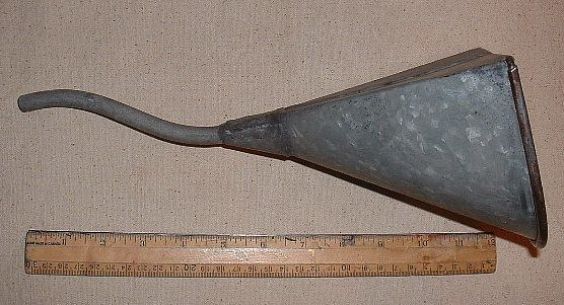
Military issue funnel. Photo Courtesy Grant Rombough. Click on pic for larger view.
- Cleaning after Firing Blank .--(
I have cleaned a rifle using hot water, pull through and 4" x 2" "flannelette". It works quite well. There is also a dandy little item available from Hoppe's called a "Bore Snake". This modern adaptation of the pull through is a really great deal and I now own one for every caliber I shoot from .22 to 12 Ga.
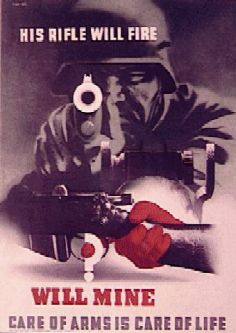
Observations: Unfortunately, the original web site at http://www.smellysmleshooters.net, originally run for many years by Sean, as since disappeared and appears to be no longer operating. So, in the interests of saving this excellent article by Lewis "Vulture" Maynard and originally published on Seean's site, we've used the Internet "wayback" machine software to resurrect it and republish it for free here, for the benefit of all Enfield collectors around the world.
Collector's Comments and Feedback:










 Reply
Reply
 Countries
Countries Categories
Categories Recent Article Comments
Recent Article Comments
